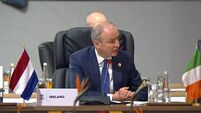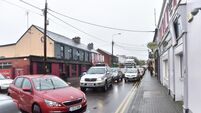For sale
That was the stark admission, not of an anti-prostitution campaigner or women’s rights activist, but of the assistant chief constable of the Police Service of Northern Ireland (PSNI) and it was made during a Stormont Public Accounts Committee meeting last month.
Drew Harris confirmed his officers had recently rescued a young orphaned girl who was trafficked there through four different countries and that she was one of 20 people who was rescued directly by the PSNI since 2006.
South of the border, there are no such pronouncements by senior police officers, no acknowledgement that women are being forced into the sex trade here against their will. Not one person has been convicted of trafficking in the last 10 years.
This can lead to the conclusion that, either the Republic is miraculously escaping the scourge of what is a worldwide crime, or the authorities are not focused on tracing those responsible for bringing the problem into our towns and cities.
The latter, would appear to be the more likely, statistically.
It is now widely accepted that at any one time there are up to 1,000 women offering sex for sale behind closed doors around the country in the various cities and large towns. The illegality which surrounds prostitution means these women stay under the police radar and therefore their identities are, for the most part, unknown.
They enter the country under the pretence of looking for legitimate work. Often those not entitled to automatic entry to Ireland due to their non-EU status will have false documentation which disguises their true origin or false paperwork which gets them through customs.
The opportunities this creates for traffickers are significant. It is hardly surprising then that Ruhama, the organisation which helps women caught up in prostitution, worked with 43 women who were presumed victims of human trafficking for sexual exploitation in 2007 and 57 presumed victims in 2008.
The cases of the vast majority of those women were forwarded to the gardaí. No convictions resulted.
When one looks at the figures for women helped by Ruhama, one sees further evidence of the covert nature of the prostitution industry.
If one were to look at one of the main prostitution websites, it has more than 50 women listed as “black”. When one looks at each individual’s nationality almost all claim to be either South American or European. Not one is listed as Nigerian.
Yet of the many coloured women helped by Ruhama over the last few years, the majority are from Nigeria, specifically the Edo Province. And of the few cases of suspected human trafficking that have made the courts – and failed to reach conviction for the trafficking crime – many have involved Nigerian women.
Technology has contributed to the ease with which the sex industry in this country has grown and also to the opportunities which are open to traffickers to remain under the radar.
The escort-ireland.com website has, at any one time, more than 600 women listed as available to see prospective punters.
While the website does say it is opposed to any form of human trafficking – it has sections dedicated to the issue – its opponents point out that its very existence, the mass advertisement of women whose bodies are for sale, lends itself to the exploitation of those who cannot speak out about the situation in which they find themselves.
Escort-ireland.com exists on the margins of legality. Advertisement of prostitution is illegal in this country.
However, the website gets away with marketing prostitutes for hire in Ireland because it hosts itself outside the state.
Its name has been mentioned in a number of court cases where prostitution has been investigated. In the most recent case, a Romanian man was prosecuted following the presentation of evidence claiming he had beaten his prostitutes and threatened to starve one.
In 2009, research commissioned by the Immigrant Council of Ireland (ICI) identified 102 women and girls who had been trafficked into or through this country for the purposes of sexual exploitation over a period of less than two years.
In “Globalisation, Sex Trafficking and Prostitution – The Experiences of Migrant Women in Ireland” (see Lisa’s story below) the researchers collated information about the women who had been located by 10 support services in only the 21 months between January 2007 and September 2008.
Most worryingly, the research found 11% of the 102 women trafficked were children at the time they were brought to Ireland. Seven were children (ie less then 18 years) at the time of the research and four others were under the age of 18 when they were trafficked into Ireland. The largest category (48%) was between 18 to 24 years.
Proving that the trafficking of women in this country was no new phenomenon, research by two Irish academics, Dr Eilis Ward of the National University of Ireland, Galway, and Dr Gillian Wylie of the Irish School of Ecumenics at Trinity College, identified 76 victims of trafficking in the years from 2000-2006.
Like the research by ICI their statistics revealed that the majority of women were trafficked from Eastern Europe as well as Africa, Asia and South America and that the majority ended up in private brothels.
One woman they reported upon was kept in an apartment in the Financial Services Centre in Dublin and forced to have sex with men. Another woman was regularly beaten by her captors, moved around Ireland and kept through physical force.
The researchers came upon another woman who reported she had been moved by her traffickers between Ireland and Britain. She told them a gun was shown to her during her transit. While she met other women during this period, she was kept isolated from them. She was given clothes and make up by her captors.
“In another case for which considerable details were available, a woman was brought to Ireland by a fellow national and once here was sold to an Irish person to work in a lap-dancing club and, it is believed, in prostitution,” they said.
Yet in spite of highly qualified people creating detailed accounts of women who have been the victims of trafficking, an April 2009 report in the Sunday media cast doubt that there was any significant problem.
It claimed gardaí had carried out a major investigation into prostitution in Ireland and “had found no evidence of organised trafficking”.
That conclusion is at odds with the information provided at the gardaí’s own Immigration Conference in 2006, when it was revealed that in the space of just 12 months almost 1,100 illegal immigrants had been stopped trying to enter the Republic from Northern Ireland alone.
A total of 5,436 people had been refused entry at ports, an increase of 500 on the previous year.
At that conference, Phil Taylor, director of the Scotland and Northern Ireland section of the British immigration and nationality department tasked with stopping the flow from the North, said, as far his department was concerned, the trafficking of girls and children was the one area that caused his department the most sleepless nights. He said there was clear evidence of sex workers being moved between Britain and Ireland.












